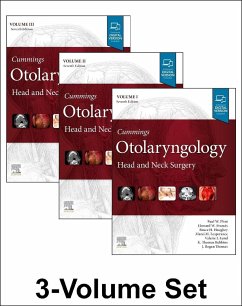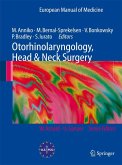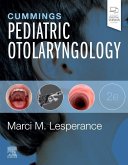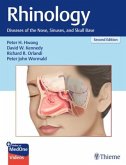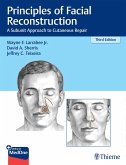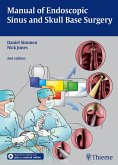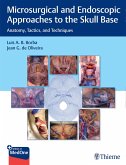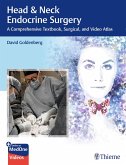Paul W. Flint, Bruce H. Haughey, Valerie J. Lund, K. Thomas Robbins, J. Regan Thomas, Marci M. Lesperance, Howard W. Francis
Cummings Otolaryngology
Head and Neck Surgery, 3-Volume Set
Schade – dieser Artikel ist leider ausverkauft. Sobald wir wissen, ob und wann der Artikel wieder verfügbar ist, informieren wir Sie an dieser Stelle.
Paul W. Flint, Bruce H. Haughey, Valerie J. Lund, K. Thomas Robbins, J. Regan Thomas, Marci M. Lesperance, Howard W. Francis
Cummings Otolaryngology
Head and Neck Surgery, 3-Volume Set
- Gebundenes Buch
- Merkliste
- Auf die Merkliste
- Bewerten Bewerten
- Teilen
- Produkt teilen
- Produkterinnerung
- Produkterinnerung
The most comprehensive, multi-disciplinary text in the field, Cummings Otolaryngology: Head and Neck Surgery, 7th Edition, provides detailed, practical answers and easily accessible clinical content on the complex issues that arise for otolaryngologists at all levels, across all subspecialties. This award-winning text is a one-stop reference for all stages of your career-from residency and board certification through the challenges faced in daily clinical practice. Updated content, new otology editor Dr. Howard W. Francis, and new chapters and videos ensure that this 7th Edition remains the definitive reference in today's otolaryngology.…mehr
Andere Kunden interessierten sich auch für
![Otorhinolaryngology, Head and Neck Surgery Otorhinolaryngology, Head and Neck Surgery]() Matti Anniko / Manuel Bernal-Sprekelsen / Victor et al. Bonkowsky (Volume editor)Otorhinolaryngology, Head and Neck Surgery128,99 €
Matti Anniko / Manuel Bernal-Sprekelsen / Victor et al. Bonkowsky (Volume editor)Otorhinolaryngology, Head and Neck Surgery128,99 €![Cummings Pediatric Otolaryngology Cummings Pediatric Otolaryngology]() Cummings Pediatric Otolaryngology164,99 €
Cummings Pediatric Otolaryngology164,99 €![Rhinology Rhinology]() Rhinology193,99 €
Rhinology193,99 €![Principles of Facial Reconstruction Principles of Facial Reconstruction]() Wayne F. LarrabeePrinciples of Facial Reconstruction159,00 €
Wayne F. LarrabeePrinciples of Facial Reconstruction159,00 €![Manual of Endoscopic Sinus and Skull Base Surgery Manual of Endoscopic Sinus and Skull Base Surgery]() Daniel SimmenManual of Endoscopic Sinus and Skull Base Surgery189,99 €
Daniel SimmenManual of Endoscopic Sinus and Skull Base Surgery189,99 €![Microsurgical and Endoscopic Approaches to the Skull Base Microsurgical and Endoscopic Approaches to the Skull Base]() Luis BorbaMicrosurgical and Endoscopic Approaches to the Skull Base165,99 €
Luis BorbaMicrosurgical and Endoscopic Approaches to the Skull Base165,99 €![Head & Neck Endocrine Surgery Head & Neck Endocrine Surgery]() David GoldenbergHead & Neck Endocrine Surgery178,99 €
David GoldenbergHead & Neck Endocrine Surgery178,99 €-
-
-
The most comprehensive, multi-disciplinary text in the field, Cummings Otolaryngology: Head and Neck Surgery, 7th Edition, provides detailed, practical answers and easily accessible clinical content on the complex issues that arise for otolaryngologists at all levels, across all subspecialties. This award-winning text is a one-stop reference for all stages of your career-from residency and board certification through the challenges faced in daily clinical practice. Updated content, new otology editor Dr. Howard W. Francis, and new chapters and videos ensure that this 7th Edition remains the definitive reference in today's otolaryngology.
Produktdetails
- Produktdetails
- Verlag: Elsevier LTD
- 7. Auflage
- Seitenzahl: 3568
- Erscheinungstermin: Juli 2020
- Englisch
- Abmessung: 285mm x 227mm x 137mm
- Gewicht: 7888g
- ISBN-13: 9780323611794
- ISBN-10: 0323611796
- Artikelnr.: 58463183
- Herstellerkennzeichnung
- Libri GmbH
- Europaallee 1
- 36244 Bad Hersfeld
- gpsr@libri.de
- Verlag: Elsevier LTD
- 7. Auflage
- Seitenzahl: 3568
- Erscheinungstermin: Juli 2020
- Englisch
- Abmessung: 285mm x 227mm x 137mm
- Gewicht: 7888g
- ISBN-13: 9780323611794
- ISBN-10: 0323611796
- Artikelnr.: 58463183
- Herstellerkennzeichnung
- Libri GmbH
- Europaallee 1
- 36244 Bad Hersfeld
- gpsr@libri.de
Paul W. Flint, MD received his medical degree from Baylor College of Medicine and completed his residency training at the University of Washington. He joined the faculty at Johns Hopkins in 1991, where he served as Residency Training Program Director. In 2009, Dr. Flint was appointed Professor and Chair, Otolaryngology - Head &Neck Surgery at Oregon Health & Science University. He is a founding member of the Society for Airway Management, and an active member of The Triological Society, The American Laryngological Society, The American Academy of Otolaryngology, and The American College of Surgeons. Dr. Flint's clinical interests include the treatment of benign and malignant diseases of the airway, development of procedures to improve voice, swallowing, and breathing; and, treatment of movement disorders affecting the head and neck, including dystonia and Parkinson disease.
Flint: CUMMINGS OTOLARYNGOLOGY, 7e Preface Part I: Measuring Outcomes and Performance 1. Outcomes Research
2. Interpreting Medical Data 3. Evidence-Based Performance Measurement Part II: General Otolaryngology 4. History, Physical Examination, and the Preoperative Evaluation 5. General Considerations of Anesthesia and Management of the Difficult Airway 6. Surgical Management of the Difficult Adult Airway 7. Tracheotomy
8. Overview of Diagnostic Imaging of the Head and Neck 9. Deep Neck and Odontogenic Infections 10. Head and Neck Manifestations in the Immunocompromised Host 11. Laryngeal and Tracheal Manifestations of Systemic Disease 12. Oral Manifestations of Systemic Diseases
13. Otolaryngology in the Elderly 14. Pain Management in the Head and Neck Patient 15. Sleep Apnea and Sleep Disorders Part III: Facial Plastic and Reconstructive Surgery Section 1: Facial Surgery 16. Aesthetic Facial Analysis 17. Recognition and Treatment of Skin Lesions 18. Scar Revision, Keloids, and Camouflage 19. Facial Trauma: Soft Tissue Lacerations and Burns 20. Maxillofacial Trauma 21. Reconstruction of Facial Defects 22. Hair Restoration: Medical and Surgical Techniques 23. Management of Aging Skin 24. Rhytidectomy and Facial Liposuction 25. The Aesthetic Brow and Forehead 26. Blepharoplasty 27. Mentoplasty 28. Otoplasty Section 2: Rhinoplasty 29. The Nasal Septum 30. Nasal Fractures 31. Rhinoplasty 32. Special Rhinoplasty Techniques 33. Non-Caucasian Rhinoplasty 34. Revision Rhinoplasty Part IV: Sinus, Rhinology and Allergy/Immunology 35. Allergy and Immunology of the Upper Airway 36. Olfactory function and dysfunction 37. Objective Assessment of Nasal Function 38. Imaging of Nose and Sinuses 39. Non-allergic Rhinitis 40. Acute Rhinosinusitis: Pathogenesis, Treatment and Complications 41. Pathogenesis of Chronic Rhinosinusitis 42. Chronic Rhinosinusitis: Evidence based Medical Treatment 43. Chronic Rhinosinusitis: Outcomes of Medical and Surgical Treatment 44. Primary Sinus Surgery 45. Causes of Failure, Revision Surgery for Rhinosinusitis, and Management of Complications in Endoscopic Sinus Surgery 46. Management of the Frontal Sinuses 47. Epistaxis 48. Cerebrospinal Fluid Rhinorrhea 49. Sino-orbital Interface 50. Benign Tumors of the Sinonasal Tract 51. Systemic Disease of the Nose and Sinuses 52. Facial Pain Part V: Laryngology and Bronchoesophagology 53. Laryngeal and Pharyngeal Function 54. Visual Documentation of the Larynx 55. Voice Evaluation and Therapy 56. Neurologic Evaluation of the Larynx and Pharynx 57. Neurologic Disorders of the Larynx 58. The Professional Voice 59. Laser Surgery: Basic Principles and Safety Considerations 60. Benign Vocal Fold Mucosal Disorders 61. Acute and Chronic Laryngopharyngitis 62. Medialization Thyroplasty 63. Arytenoid Adduction and Abduction 64. Laryngeal Reinnervation 65. Chronic Aspiration 66. Laryngeal and Esophageal Trauma 67. Surgical Management of Upper Airway Stenosis 68. Diseases of the Esophagus 69. Transnasal Esophagoscopy 70. Zenker Diverticulum 71. Tracheobronchial Endoscopy Part VI: Head and Neck Surgery and Oncology Section 1: General Considerations 72. Fundamentals of Molecular Biology and Gene Therapy 73. Biology of Head and Neck Cancers 74. Human Papillomavirus (HPV) and the Epidemiology of Head and Neck Cancer 75. Radiotherapy for Head and Neck Cancer: Radiation Physics, Radiobiology, and Clinical Principles 76. Chemotherapy and Targeted Biologic Agents for Head and Neck Cancer 77. Skin Flap Physiology and Wound Healing 78. Free Tissue Transfer 79. Integrating Palliative and Curative Care Strategies in the Practice of Otolaryngology 80. The Management of Cutaneous Head and Neck Melanoma Section 2: Salivary Glands 81. Physiology of the Salivary Glands 82. Diagnostic Imaging and Fine-needle Aspiration of the Salivary Glands 83. Inflammatory Disorders of the Salivary Glands 84. Benign Neoplasms of the Salivary Glands 85. Malignant Neoplasms of the Salivary Glands Section 3: Oral Cavity 86. Physiology of the Oral Cavity 87. Oral Mucosal Lesions 88. Odontogenesis, Odontogenic Cysts, and Odontogenic Tumors 89. Temporomandibular Joint Disorders 90. Benign Tumors and Tumor-like Lesions of the Oral Cavity 91. Malignant Neoplasms of the Oral Cavity 92. Reconstruction of the Mandible and Maxilla 93. Prosthetic Management of Head and Neck Defects 94. Malignancies of the Paranasal Sinus Section 4: Pharynx and Esophagus 95. Benign and Malignant Tumors of the Nasopharynx 96. Malignant Neoplasms of the Oropharynx 97. Transoral Approaches to Malignant Neoplasms of the Oropharynx 98. Reconstruction of the Oropharynx 99. Swallowing Function and Implications in Head and Neck Cancer 100. Diagnostic Imaging of the Pharynx and Esophagus 101. Neoplasms of the Hypopharynx and Cervical Esophagus 102. Radiotherapy and Chemotherapy of Squamous Cell Carcinomas of the Hypopharynx and Esophagus 103. Reconstruction of the Hypopharynx and Esophagus Section 5: Larynx 104. Diagnostic Imaging of the Larynx 105. Malignant Tumors of the Larynx 106. Management of Early Glottic Cancer 107. Transoral Laser Microresection of Advanced Laryngeal Tumors 108. Conservation Laryngeal Surgery 109. Total Laryngectomy and Laryngopharyngectomy 110. Radiation Therapy for Cancer of the Larynx and Hypopharynx 111. Vocal and Speech Rehabilitation After Laryngectomy 112. Diagnosis and Management of Tracheal Neoplasms Section 6: Neck 113. Differential Diagnosis of Neck Masses 114. Ultrasound Imaging of the Neck 115. Neoplasms of the Neck 116. Lymphomas Presenting in the Head and Neck 117. Radiation Therapy and Management of the Cervical Lymph Nodes and Malignant Skull Base Tumors 118. Neck Dissection 119. Complications of Neck Surgery 120. Penetrating and Blunt Trauma to the Neck Section 7: Thyroid/Parathyroid 121. Disorders of the Thyroid Gland 122. Management of Thyroid Neoplasms 123. Management of Parathyroid Disorders 124. Surgical Robotics in Otolaryngology 125. Management of Thyroid Eye Disease (Graves' Ophthalmopathy) Part VII: Otology, Neurotology, and Skull Base Surgery Section 1: Basic Science 126. Anatomy of the Temporal Bone, External Ear, and Middle Ear 127. NEUROANATOMY OF THE AUDITORY SYSTEM 128. Physiology of the Auditory System 129. Anatomy of the Vestibular System 130. Anatomy and Physiology of the Eustachian Tube 131. Clinical Evaluation and Management of the Eustachian Tube 132. CORTICAL NEUROPLASTICITY IN HEARING LOSS 133. Geriatric Otology: Population Health and Clinical Implications Section 2: Diagnostic Assessment 134. Diagnostic Audiology and Electrophysiologic Assessment of Hearing 135. Neuroradiology of the Temporal Bone and Skull Base 136. Interventional Neuroradiology of the Skull Base, Head and Neck 137. Otologic Symptoms and Syndromes Section 3: External Ear 138. Infections of the External Ear 139. Topical Therapies of External Ear Disorders Section 4: Middle Ear, Mastoid and Temporal Bone 140. Chronic Otitis Media, Mastoiditis, and Petrositis 141. Complications of Temporal Bone Infections 142. Tympanoplasty and Ossiculoplasty 143. Mastoidectomy: Surgical Techniques 144. Middle Ear Endoscopic Surgery 145. Clinical Assessment and Surgical Treatment of Conductive Hearing Loss 146. Otosclerosis 147. Management of Temporal Bone Trauma Section 5: Inner Ear 148. Cochlear Transduction and the Molecular Basis of Auditory Pathology 149. Genetics of Ear Disorders 150. Genetic Sensorineural Hearing Loss 151. Otologic Manifestations of Systemic Disease 152. Sensorineural Hearing Loss in Adults 153. Tinnitus and Hyperacusis 154. Noise-Induced Hearing Loss 155. Infections of the Labyrinth 156. Autoimmune Inner-Ear Disease 157. Vestibular and Auditory Ototoxicity 158. Pharmacologic and Molecular Therapies of the Cochlear and Vestibular Labyrinth Section 6: Auditory Prosthetic Stimulation, Devices, and Rehabilitative Audiology 159. Implantable Hearing Devices 160. Cochlear Implantation: Patient Evaluation and Device Selection 161. Medical and Surgical Considerations in Cochlear Implantation 162. Cochlear Implantation in Adults: Results, Outcomes and Rehabilitation 163. Auditory Brainstem Implantation 164. Hearing Aid Amplification Section 7: Vestibular Disorders 165. Principles of Applied Vestibular Physiology 166. Evaluation of the Patient with Dizziness 167. Peripheral Vestibular Disorders 168. Central Vestibular Disorders 169. Surgery for Vestibular Disorders 170. Vestibular and Balance Rehabilitation Therapy: Program Essentials Section 8: Facial Nerve Disorders 171. Tests of Facial Nerve Function 172. Clinical Disorders of the Facial Nerve 173. Intratermporal Facial Nerve Surgery 174. Rehabilitation of Facial Paralysis Section 9: Cranial Base 175. Surgical Anatomy of the Lateral Skull Base 176. Surgery of the Anterior and Middle Cranial Base 177. Transnasal Endoscopic-Assisted Surgery of the Anterior Skull Base 178. Temporal Bone Neoplasms and Lateral Cranial Base Surgery 179. Neoplasms of the Posterior Fossa 180. Intraoperative Monitoring of Cranial Nerves in Neurotologic Surgery 181. Radiation Therapy of Benign Tumors of the Cranial Base Part VIII: Pediatric Otolaryngology Section 1: General 182. General Considerations in Pediatric Otolaryngology 183. Pediatric Speech Disorders 184. Anesthesia in Pediatric Otolaryngology 185. Nonobstructive Pediatric Sleep Disorders 186. Evaluation and Management of Pediatric Obstructive Sleep Apnea Section 2: Craniofacial 187. Craniofacial Surgery for Congenital and Acquired Deformities 188. Cleft Lip and Palate 189. Velopharyngeal Dysfunction 190. Congenital and Acquired Malformations of the Nose and Nasopharynx 191. Pediatric Facial Fractures Section 3: Hearing Loss and Pediatric Otology 192. Pediatric Otologic Surgery 193. Early Detection and Diagnosis of Infant Hearing Impairment 194. Congenital Malformations of the Inner Ear 195. Microtia Reconstruction 196. Pediatric Cochlear Implantation 197. Evaluation and Management of Congenital Aural Atresia 198. Evaluation and Management of Pediatric Vestibular Disorders Section 4: Infections and Inflammation 199. Acute Otitis Media and Otitis Media with Effusion 200. Pediatric Chronic Rhinosinusitis 201. Pediatric Infectious Disease Section 5: Head and Neck 202. Congenital and Inflammatory Neck Masses in Children 203. Vascular Anomalies of the Head and Neck 204. Pediatric Head and Neck Neoplasms 205. Salivary Gland Disease in Children Section 6: Pharynx, Larynx, Trachea and Esophagus 206. Evaluation and Management of the Pediatric Airway 207. Tongue-Ties and Lip Ties 208. Recurrent Respiratory Papillomatosis 209. Glottic and Subglottic Stenosis and Related Voice Disorders 210. Diagnosis and Management of Tracheal Anomalies and Tracheal Stenosis 211. Aerodigestive Foreign Bodies and Caustic Ingestions 212. Pediatric Swallowing, Laryngopharyngeal and Gastroesophageal Reflux Disease, Eosinophilic Esophagitis, and Aspiration 213. Pediatric Tracheotomy and Decannulation 214. Laryngotracheal Clefts
2. Interpreting Medical Data 3. Evidence-Based Performance Measurement Part II: General Otolaryngology 4. History, Physical Examination, and the Preoperative Evaluation 5. General Considerations of Anesthesia and Management of the Difficult Airway 6. Surgical Management of the Difficult Adult Airway 7. Tracheotomy
8. Overview of Diagnostic Imaging of the Head and Neck 9. Deep Neck and Odontogenic Infections 10. Head and Neck Manifestations in the Immunocompromised Host 11. Laryngeal and Tracheal Manifestations of Systemic Disease 12. Oral Manifestations of Systemic Diseases
13. Otolaryngology in the Elderly 14. Pain Management in the Head and Neck Patient 15. Sleep Apnea and Sleep Disorders Part III: Facial Plastic and Reconstructive Surgery Section 1: Facial Surgery 16. Aesthetic Facial Analysis 17. Recognition and Treatment of Skin Lesions 18. Scar Revision, Keloids, and Camouflage 19. Facial Trauma: Soft Tissue Lacerations and Burns 20. Maxillofacial Trauma 21. Reconstruction of Facial Defects 22. Hair Restoration: Medical and Surgical Techniques 23. Management of Aging Skin 24. Rhytidectomy and Facial Liposuction 25. The Aesthetic Brow and Forehead 26. Blepharoplasty 27. Mentoplasty 28. Otoplasty Section 2: Rhinoplasty 29. The Nasal Septum 30. Nasal Fractures 31. Rhinoplasty 32. Special Rhinoplasty Techniques 33. Non-Caucasian Rhinoplasty 34. Revision Rhinoplasty Part IV: Sinus, Rhinology and Allergy/Immunology 35. Allergy and Immunology of the Upper Airway 36. Olfactory function and dysfunction 37. Objective Assessment of Nasal Function 38. Imaging of Nose and Sinuses 39. Non-allergic Rhinitis 40. Acute Rhinosinusitis: Pathogenesis, Treatment and Complications 41. Pathogenesis of Chronic Rhinosinusitis 42. Chronic Rhinosinusitis: Evidence based Medical Treatment 43. Chronic Rhinosinusitis: Outcomes of Medical and Surgical Treatment 44. Primary Sinus Surgery 45. Causes of Failure, Revision Surgery for Rhinosinusitis, and Management of Complications in Endoscopic Sinus Surgery 46. Management of the Frontal Sinuses 47. Epistaxis 48. Cerebrospinal Fluid Rhinorrhea 49. Sino-orbital Interface 50. Benign Tumors of the Sinonasal Tract 51. Systemic Disease of the Nose and Sinuses 52. Facial Pain Part V: Laryngology and Bronchoesophagology 53. Laryngeal and Pharyngeal Function 54. Visual Documentation of the Larynx 55. Voice Evaluation and Therapy 56. Neurologic Evaluation of the Larynx and Pharynx 57. Neurologic Disorders of the Larynx 58. The Professional Voice 59. Laser Surgery: Basic Principles and Safety Considerations 60. Benign Vocal Fold Mucosal Disorders 61. Acute and Chronic Laryngopharyngitis 62. Medialization Thyroplasty 63. Arytenoid Adduction and Abduction 64. Laryngeal Reinnervation 65. Chronic Aspiration 66. Laryngeal and Esophageal Trauma 67. Surgical Management of Upper Airway Stenosis 68. Diseases of the Esophagus 69. Transnasal Esophagoscopy 70. Zenker Diverticulum 71. Tracheobronchial Endoscopy Part VI: Head and Neck Surgery and Oncology Section 1: General Considerations 72. Fundamentals of Molecular Biology and Gene Therapy 73. Biology of Head and Neck Cancers 74. Human Papillomavirus (HPV) and the Epidemiology of Head and Neck Cancer 75. Radiotherapy for Head and Neck Cancer: Radiation Physics, Radiobiology, and Clinical Principles 76. Chemotherapy and Targeted Biologic Agents for Head and Neck Cancer 77. Skin Flap Physiology and Wound Healing 78. Free Tissue Transfer 79. Integrating Palliative and Curative Care Strategies in the Practice of Otolaryngology 80. The Management of Cutaneous Head and Neck Melanoma Section 2: Salivary Glands 81. Physiology of the Salivary Glands 82. Diagnostic Imaging and Fine-needle Aspiration of the Salivary Glands 83. Inflammatory Disorders of the Salivary Glands 84. Benign Neoplasms of the Salivary Glands 85. Malignant Neoplasms of the Salivary Glands Section 3: Oral Cavity 86. Physiology of the Oral Cavity 87. Oral Mucosal Lesions 88. Odontogenesis, Odontogenic Cysts, and Odontogenic Tumors 89. Temporomandibular Joint Disorders 90. Benign Tumors and Tumor-like Lesions of the Oral Cavity 91. Malignant Neoplasms of the Oral Cavity 92. Reconstruction of the Mandible and Maxilla 93. Prosthetic Management of Head and Neck Defects 94. Malignancies of the Paranasal Sinus Section 4: Pharynx and Esophagus 95. Benign and Malignant Tumors of the Nasopharynx 96. Malignant Neoplasms of the Oropharynx 97. Transoral Approaches to Malignant Neoplasms of the Oropharynx 98. Reconstruction of the Oropharynx 99. Swallowing Function and Implications in Head and Neck Cancer 100. Diagnostic Imaging of the Pharynx and Esophagus 101. Neoplasms of the Hypopharynx and Cervical Esophagus 102. Radiotherapy and Chemotherapy of Squamous Cell Carcinomas of the Hypopharynx and Esophagus 103. Reconstruction of the Hypopharynx and Esophagus Section 5: Larynx 104. Diagnostic Imaging of the Larynx 105. Malignant Tumors of the Larynx 106. Management of Early Glottic Cancer 107. Transoral Laser Microresection of Advanced Laryngeal Tumors 108. Conservation Laryngeal Surgery 109. Total Laryngectomy and Laryngopharyngectomy 110. Radiation Therapy for Cancer of the Larynx and Hypopharynx 111. Vocal and Speech Rehabilitation After Laryngectomy 112. Diagnosis and Management of Tracheal Neoplasms Section 6: Neck 113. Differential Diagnosis of Neck Masses 114. Ultrasound Imaging of the Neck 115. Neoplasms of the Neck 116. Lymphomas Presenting in the Head and Neck 117. Radiation Therapy and Management of the Cervical Lymph Nodes and Malignant Skull Base Tumors 118. Neck Dissection 119. Complications of Neck Surgery 120. Penetrating and Blunt Trauma to the Neck Section 7: Thyroid/Parathyroid 121. Disorders of the Thyroid Gland 122. Management of Thyroid Neoplasms 123. Management of Parathyroid Disorders 124. Surgical Robotics in Otolaryngology 125. Management of Thyroid Eye Disease (Graves' Ophthalmopathy) Part VII: Otology, Neurotology, and Skull Base Surgery Section 1: Basic Science 126. Anatomy of the Temporal Bone, External Ear, and Middle Ear 127. NEUROANATOMY OF THE AUDITORY SYSTEM 128. Physiology of the Auditory System 129. Anatomy of the Vestibular System 130. Anatomy and Physiology of the Eustachian Tube 131. Clinical Evaluation and Management of the Eustachian Tube 132. CORTICAL NEUROPLASTICITY IN HEARING LOSS 133. Geriatric Otology: Population Health and Clinical Implications Section 2: Diagnostic Assessment 134. Diagnostic Audiology and Electrophysiologic Assessment of Hearing 135. Neuroradiology of the Temporal Bone and Skull Base 136. Interventional Neuroradiology of the Skull Base, Head and Neck 137. Otologic Symptoms and Syndromes Section 3: External Ear 138. Infections of the External Ear 139. Topical Therapies of External Ear Disorders Section 4: Middle Ear, Mastoid and Temporal Bone 140. Chronic Otitis Media, Mastoiditis, and Petrositis 141. Complications of Temporal Bone Infections 142. Tympanoplasty and Ossiculoplasty 143. Mastoidectomy: Surgical Techniques 144. Middle Ear Endoscopic Surgery 145. Clinical Assessment and Surgical Treatment of Conductive Hearing Loss 146. Otosclerosis 147. Management of Temporal Bone Trauma Section 5: Inner Ear 148. Cochlear Transduction and the Molecular Basis of Auditory Pathology 149. Genetics of Ear Disorders 150. Genetic Sensorineural Hearing Loss 151. Otologic Manifestations of Systemic Disease 152. Sensorineural Hearing Loss in Adults 153. Tinnitus and Hyperacusis 154. Noise-Induced Hearing Loss 155. Infections of the Labyrinth 156. Autoimmune Inner-Ear Disease 157. Vestibular and Auditory Ototoxicity 158. Pharmacologic and Molecular Therapies of the Cochlear and Vestibular Labyrinth Section 6: Auditory Prosthetic Stimulation, Devices, and Rehabilitative Audiology 159. Implantable Hearing Devices 160. Cochlear Implantation: Patient Evaluation and Device Selection 161. Medical and Surgical Considerations in Cochlear Implantation 162. Cochlear Implantation in Adults: Results, Outcomes and Rehabilitation 163. Auditory Brainstem Implantation 164. Hearing Aid Amplification Section 7: Vestibular Disorders 165. Principles of Applied Vestibular Physiology 166. Evaluation of the Patient with Dizziness 167. Peripheral Vestibular Disorders 168. Central Vestibular Disorders 169. Surgery for Vestibular Disorders 170. Vestibular and Balance Rehabilitation Therapy: Program Essentials Section 8: Facial Nerve Disorders 171. Tests of Facial Nerve Function 172. Clinical Disorders of the Facial Nerve 173. Intratermporal Facial Nerve Surgery 174. Rehabilitation of Facial Paralysis Section 9: Cranial Base 175. Surgical Anatomy of the Lateral Skull Base 176. Surgery of the Anterior and Middle Cranial Base 177. Transnasal Endoscopic-Assisted Surgery of the Anterior Skull Base 178. Temporal Bone Neoplasms and Lateral Cranial Base Surgery 179. Neoplasms of the Posterior Fossa 180. Intraoperative Monitoring of Cranial Nerves in Neurotologic Surgery 181. Radiation Therapy of Benign Tumors of the Cranial Base Part VIII: Pediatric Otolaryngology Section 1: General 182. General Considerations in Pediatric Otolaryngology 183. Pediatric Speech Disorders 184. Anesthesia in Pediatric Otolaryngology 185. Nonobstructive Pediatric Sleep Disorders 186. Evaluation and Management of Pediatric Obstructive Sleep Apnea Section 2: Craniofacial 187. Craniofacial Surgery for Congenital and Acquired Deformities 188. Cleft Lip and Palate 189. Velopharyngeal Dysfunction 190. Congenital and Acquired Malformations of the Nose and Nasopharynx 191. Pediatric Facial Fractures Section 3: Hearing Loss and Pediatric Otology 192. Pediatric Otologic Surgery 193. Early Detection and Diagnosis of Infant Hearing Impairment 194. Congenital Malformations of the Inner Ear 195. Microtia Reconstruction 196. Pediatric Cochlear Implantation 197. Evaluation and Management of Congenital Aural Atresia 198. Evaluation and Management of Pediatric Vestibular Disorders Section 4: Infections and Inflammation 199. Acute Otitis Media and Otitis Media with Effusion 200. Pediatric Chronic Rhinosinusitis 201. Pediatric Infectious Disease Section 5: Head and Neck 202. Congenital and Inflammatory Neck Masses in Children 203. Vascular Anomalies of the Head and Neck 204. Pediatric Head and Neck Neoplasms 205. Salivary Gland Disease in Children Section 6: Pharynx, Larynx, Trachea and Esophagus 206. Evaluation and Management of the Pediatric Airway 207. Tongue-Ties and Lip Ties 208. Recurrent Respiratory Papillomatosis 209. Glottic and Subglottic Stenosis and Related Voice Disorders 210. Diagnosis and Management of Tracheal Anomalies and Tracheal Stenosis 211. Aerodigestive Foreign Bodies and Caustic Ingestions 212. Pediatric Swallowing, Laryngopharyngeal and Gastroesophageal Reflux Disease, Eosinophilic Esophagitis, and Aspiration 213. Pediatric Tracheotomy and Decannulation 214. Laryngotracheal Clefts
Flint: CUMMINGS OTOLARYNGOLOGY, 7e Preface Part I: Measuring Outcomes and Performance 1. Outcomes Research
2. Interpreting Medical Data 3. Evidence-Based Performance Measurement Part II: General Otolaryngology 4. History, Physical Examination, and the Preoperative Evaluation 5. General Considerations of Anesthesia and Management of the Difficult Airway 6. Surgical Management of the Difficult Adult Airway 7. Tracheotomy
8. Overview of Diagnostic Imaging of the Head and Neck 9. Deep Neck and Odontogenic Infections 10. Head and Neck Manifestations in the Immunocompromised Host 11. Laryngeal and Tracheal Manifestations of Systemic Disease 12. Oral Manifestations of Systemic Diseases
13. Otolaryngology in the Elderly 14. Pain Management in the Head and Neck Patient 15. Sleep Apnea and Sleep Disorders Part III: Facial Plastic and Reconstructive Surgery Section 1: Facial Surgery 16. Aesthetic Facial Analysis 17. Recognition and Treatment of Skin Lesions 18. Scar Revision, Keloids, and Camouflage 19. Facial Trauma: Soft Tissue Lacerations and Burns 20. Maxillofacial Trauma 21. Reconstruction of Facial Defects 22. Hair Restoration: Medical and Surgical Techniques 23. Management of Aging Skin 24. Rhytidectomy and Facial Liposuction 25. The Aesthetic Brow and Forehead 26. Blepharoplasty 27. Mentoplasty 28. Otoplasty Section 2: Rhinoplasty 29. The Nasal Septum 30. Nasal Fractures 31. Rhinoplasty 32. Special Rhinoplasty Techniques 33. Non-Caucasian Rhinoplasty 34. Revision Rhinoplasty Part IV: Sinus, Rhinology and Allergy/Immunology 35. Allergy and Immunology of the Upper Airway 36. Olfactory function and dysfunction 37. Objective Assessment of Nasal Function 38. Imaging of Nose and Sinuses 39. Non-allergic Rhinitis 40. Acute Rhinosinusitis: Pathogenesis, Treatment and Complications 41. Pathogenesis of Chronic Rhinosinusitis 42. Chronic Rhinosinusitis: Evidence based Medical Treatment 43. Chronic Rhinosinusitis: Outcomes of Medical and Surgical Treatment 44. Primary Sinus Surgery 45. Causes of Failure, Revision Surgery for Rhinosinusitis, and Management of Complications in Endoscopic Sinus Surgery 46. Management of the Frontal Sinuses 47. Epistaxis 48. Cerebrospinal Fluid Rhinorrhea 49. Sino-orbital Interface 50. Benign Tumors of the Sinonasal Tract 51. Systemic Disease of the Nose and Sinuses 52. Facial Pain Part V: Laryngology and Bronchoesophagology 53. Laryngeal and Pharyngeal Function 54. Visual Documentation of the Larynx 55. Voice Evaluation and Therapy 56. Neurologic Evaluation of the Larynx and Pharynx 57. Neurologic Disorders of the Larynx 58. The Professional Voice 59. Laser Surgery: Basic Principles and Safety Considerations 60. Benign Vocal Fold Mucosal Disorders 61. Acute and Chronic Laryngopharyngitis 62. Medialization Thyroplasty 63. Arytenoid Adduction and Abduction 64. Laryngeal Reinnervation 65. Chronic Aspiration 66. Laryngeal and Esophageal Trauma 67. Surgical Management of Upper Airway Stenosis 68. Diseases of the Esophagus 69. Transnasal Esophagoscopy 70. Zenker Diverticulum 71. Tracheobronchial Endoscopy Part VI: Head and Neck Surgery and Oncology Section 1: General Considerations 72. Fundamentals of Molecular Biology and Gene Therapy 73. Biology of Head and Neck Cancers 74. Human Papillomavirus (HPV) and the Epidemiology of Head and Neck Cancer 75. Radiotherapy for Head and Neck Cancer: Radiation Physics, Radiobiology, and Clinical Principles 76. Chemotherapy and Targeted Biologic Agents for Head and Neck Cancer 77. Skin Flap Physiology and Wound Healing 78. Free Tissue Transfer 79. Integrating Palliative and Curative Care Strategies in the Practice of Otolaryngology 80. The Management of Cutaneous Head and Neck Melanoma Section 2: Salivary Glands 81. Physiology of the Salivary Glands 82. Diagnostic Imaging and Fine-needle Aspiration of the Salivary Glands 83. Inflammatory Disorders of the Salivary Glands 84. Benign Neoplasms of the Salivary Glands 85. Malignant Neoplasms of the Salivary Glands Section 3: Oral Cavity 86. Physiology of the Oral Cavity 87. Oral Mucosal Lesions 88. Odontogenesis, Odontogenic Cysts, and Odontogenic Tumors 89. Temporomandibular Joint Disorders 90. Benign Tumors and Tumor-like Lesions of the Oral Cavity 91. Malignant Neoplasms of the Oral Cavity 92. Reconstruction of the Mandible and Maxilla 93. Prosthetic Management of Head and Neck Defects 94. Malignancies of the Paranasal Sinus Section 4: Pharynx and Esophagus 95. Benign and Malignant Tumors of the Nasopharynx 96. Malignant Neoplasms of the Oropharynx 97. Transoral Approaches to Malignant Neoplasms of the Oropharynx 98. Reconstruction of the Oropharynx 99. Swallowing Function and Implications in Head and Neck Cancer 100. Diagnostic Imaging of the Pharynx and Esophagus 101. Neoplasms of the Hypopharynx and Cervical Esophagus 102. Radiotherapy and Chemotherapy of Squamous Cell Carcinomas of the Hypopharynx and Esophagus 103. Reconstruction of the Hypopharynx and Esophagus Section 5: Larynx 104. Diagnostic Imaging of the Larynx 105. Malignant Tumors of the Larynx 106. Management of Early Glottic Cancer 107. Transoral Laser Microresection of Advanced Laryngeal Tumors 108. Conservation Laryngeal Surgery 109. Total Laryngectomy and Laryngopharyngectomy 110. Radiation Therapy for Cancer of the Larynx and Hypopharynx 111. Vocal and Speech Rehabilitation After Laryngectomy 112. Diagnosis and Management of Tracheal Neoplasms Section 6: Neck 113. Differential Diagnosis of Neck Masses 114. Ultrasound Imaging of the Neck 115. Neoplasms of the Neck 116. Lymphomas Presenting in the Head and Neck 117. Radiation Therapy and Management of the Cervical Lymph Nodes and Malignant Skull Base Tumors 118. Neck Dissection 119. Complications of Neck Surgery 120. Penetrating and Blunt Trauma to the Neck Section 7: Thyroid/Parathyroid 121. Disorders of the Thyroid Gland 122. Management of Thyroid Neoplasms 123. Management of Parathyroid Disorders 124. Surgical Robotics in Otolaryngology 125. Management of Thyroid Eye Disease (Graves' Ophthalmopathy) Part VII: Otology, Neurotology, and Skull Base Surgery Section 1: Basic Science 126. Anatomy of the Temporal Bone, External Ear, and Middle Ear 127. NEUROANATOMY OF THE AUDITORY SYSTEM 128. Physiology of the Auditory System 129. Anatomy of the Vestibular System 130. Anatomy and Physiology of the Eustachian Tube 131. Clinical Evaluation and Management of the Eustachian Tube 132. CORTICAL NEUROPLASTICITY IN HEARING LOSS 133. Geriatric Otology: Population Health and Clinical Implications Section 2: Diagnostic Assessment 134. Diagnostic Audiology and Electrophysiologic Assessment of Hearing 135. Neuroradiology of the Temporal Bone and Skull Base 136. Interventional Neuroradiology of the Skull Base, Head and Neck 137. Otologic Symptoms and Syndromes Section 3: External Ear 138. Infections of the External Ear 139. Topical Therapies of External Ear Disorders Section 4: Middle Ear, Mastoid and Temporal Bone 140. Chronic Otitis Media, Mastoiditis, and Petrositis 141. Complications of Temporal Bone Infections 142. Tympanoplasty and Ossiculoplasty 143. Mastoidectomy: Surgical Techniques 144. Middle Ear Endoscopic Surgery 145. Clinical Assessment and Surgical Treatment of Conductive Hearing Loss 146. Otosclerosis 147. Management of Temporal Bone Trauma Section 5: Inner Ear 148. Cochlear Transduction and the Molecular Basis of Auditory Pathology 149. Genetics of Ear Disorders 150. Genetic Sensorineural Hearing Loss 151. Otologic Manifestations of Systemic Disease 152. Sensorineural Hearing Loss in Adults 153. Tinnitus and Hyperacusis 154. Noise-Induced Hearing Loss 155. Infections of the Labyrinth 156. Autoimmune Inner-Ear Disease 157. Vestibular and Auditory Ototoxicity 158. Pharmacologic and Molecular Therapies of the Cochlear and Vestibular Labyrinth Section 6: Auditory Prosthetic Stimulation, Devices, and Rehabilitative Audiology 159. Implantable Hearing Devices 160. Cochlear Implantation: Patient Evaluation and Device Selection 161. Medical and Surgical Considerations in Cochlear Implantation 162. Cochlear Implantation in Adults: Results, Outcomes and Rehabilitation 163. Auditory Brainstem Implantation 164. Hearing Aid Amplification Section 7: Vestibular Disorders 165. Principles of Applied Vestibular Physiology 166. Evaluation of the Patient with Dizziness 167. Peripheral Vestibular Disorders 168. Central Vestibular Disorders 169. Surgery for Vestibular Disorders 170. Vestibular and Balance Rehabilitation Therapy: Program Essentials Section 8: Facial Nerve Disorders 171. Tests of Facial Nerve Function 172. Clinical Disorders of the Facial Nerve 173. Intratermporal Facial Nerve Surgery 174. Rehabilitation of Facial Paralysis Section 9: Cranial Base 175. Surgical Anatomy of the Lateral Skull Base 176. Surgery of the Anterior and Middle Cranial Base 177. Transnasal Endoscopic-Assisted Surgery of the Anterior Skull Base 178. Temporal Bone Neoplasms and Lateral Cranial Base Surgery 179. Neoplasms of the Posterior Fossa 180. Intraoperative Monitoring of Cranial Nerves in Neurotologic Surgery 181. Radiation Therapy of Benign Tumors of the Cranial Base Part VIII: Pediatric Otolaryngology Section 1: General 182. General Considerations in Pediatric Otolaryngology 183. Pediatric Speech Disorders 184. Anesthesia in Pediatric Otolaryngology 185. Nonobstructive Pediatric Sleep Disorders 186. Evaluation and Management of Pediatric Obstructive Sleep Apnea Section 2: Craniofacial 187. Craniofacial Surgery for Congenital and Acquired Deformities 188. Cleft Lip and Palate 189. Velopharyngeal Dysfunction 190. Congenital and Acquired Malformations of the Nose and Nasopharynx 191. Pediatric Facial Fractures Section 3: Hearing Loss and Pediatric Otology 192. Pediatric Otologic Surgery 193. Early Detection and Diagnosis of Infant Hearing Impairment 194. Congenital Malformations of the Inner Ear 195. Microtia Reconstruction 196. Pediatric Cochlear Implantation 197. Evaluation and Management of Congenital Aural Atresia 198. Evaluation and Management of Pediatric Vestibular Disorders Section 4: Infections and Inflammation 199. Acute Otitis Media and Otitis Media with Effusion 200. Pediatric Chronic Rhinosinusitis 201. Pediatric Infectious Disease Section 5: Head and Neck 202. Congenital and Inflammatory Neck Masses in Children 203. Vascular Anomalies of the Head and Neck 204. Pediatric Head and Neck Neoplasms 205. Salivary Gland Disease in Children Section 6: Pharynx, Larynx, Trachea and Esophagus 206. Evaluation and Management of the Pediatric Airway 207. Tongue-Ties and Lip Ties 208. Recurrent Respiratory Papillomatosis 209. Glottic and Subglottic Stenosis and Related Voice Disorders 210. Diagnosis and Management of Tracheal Anomalies and Tracheal Stenosis 211. Aerodigestive Foreign Bodies and Caustic Ingestions 212. Pediatric Swallowing, Laryngopharyngeal and Gastroesophageal Reflux Disease, Eosinophilic Esophagitis, and Aspiration 213. Pediatric Tracheotomy and Decannulation 214. Laryngotracheal Clefts
2. Interpreting Medical Data 3. Evidence-Based Performance Measurement Part II: General Otolaryngology 4. History, Physical Examination, and the Preoperative Evaluation 5. General Considerations of Anesthesia and Management of the Difficult Airway 6. Surgical Management of the Difficult Adult Airway 7. Tracheotomy
8. Overview of Diagnostic Imaging of the Head and Neck 9. Deep Neck and Odontogenic Infections 10. Head and Neck Manifestations in the Immunocompromised Host 11. Laryngeal and Tracheal Manifestations of Systemic Disease 12. Oral Manifestations of Systemic Diseases
13. Otolaryngology in the Elderly 14. Pain Management in the Head and Neck Patient 15. Sleep Apnea and Sleep Disorders Part III: Facial Plastic and Reconstructive Surgery Section 1: Facial Surgery 16. Aesthetic Facial Analysis 17. Recognition and Treatment of Skin Lesions 18. Scar Revision, Keloids, and Camouflage 19. Facial Trauma: Soft Tissue Lacerations and Burns 20. Maxillofacial Trauma 21. Reconstruction of Facial Defects 22. Hair Restoration: Medical and Surgical Techniques 23. Management of Aging Skin 24. Rhytidectomy and Facial Liposuction 25. The Aesthetic Brow and Forehead 26. Blepharoplasty 27. Mentoplasty 28. Otoplasty Section 2: Rhinoplasty 29. The Nasal Septum 30. Nasal Fractures 31. Rhinoplasty 32. Special Rhinoplasty Techniques 33. Non-Caucasian Rhinoplasty 34. Revision Rhinoplasty Part IV: Sinus, Rhinology and Allergy/Immunology 35. Allergy and Immunology of the Upper Airway 36. Olfactory function and dysfunction 37. Objective Assessment of Nasal Function 38. Imaging of Nose and Sinuses 39. Non-allergic Rhinitis 40. Acute Rhinosinusitis: Pathogenesis, Treatment and Complications 41. Pathogenesis of Chronic Rhinosinusitis 42. Chronic Rhinosinusitis: Evidence based Medical Treatment 43. Chronic Rhinosinusitis: Outcomes of Medical and Surgical Treatment 44. Primary Sinus Surgery 45. Causes of Failure, Revision Surgery for Rhinosinusitis, and Management of Complications in Endoscopic Sinus Surgery 46. Management of the Frontal Sinuses 47. Epistaxis 48. Cerebrospinal Fluid Rhinorrhea 49. Sino-orbital Interface 50. Benign Tumors of the Sinonasal Tract 51. Systemic Disease of the Nose and Sinuses 52. Facial Pain Part V: Laryngology and Bronchoesophagology 53. Laryngeal and Pharyngeal Function 54. Visual Documentation of the Larynx 55. Voice Evaluation and Therapy 56. Neurologic Evaluation of the Larynx and Pharynx 57. Neurologic Disorders of the Larynx 58. The Professional Voice 59. Laser Surgery: Basic Principles and Safety Considerations 60. Benign Vocal Fold Mucosal Disorders 61. Acute and Chronic Laryngopharyngitis 62. Medialization Thyroplasty 63. Arytenoid Adduction and Abduction 64. Laryngeal Reinnervation 65. Chronic Aspiration 66. Laryngeal and Esophageal Trauma 67. Surgical Management of Upper Airway Stenosis 68. Diseases of the Esophagus 69. Transnasal Esophagoscopy 70. Zenker Diverticulum 71. Tracheobronchial Endoscopy Part VI: Head and Neck Surgery and Oncology Section 1: General Considerations 72. Fundamentals of Molecular Biology and Gene Therapy 73. Biology of Head and Neck Cancers 74. Human Papillomavirus (HPV) and the Epidemiology of Head and Neck Cancer 75. Radiotherapy for Head and Neck Cancer: Radiation Physics, Radiobiology, and Clinical Principles 76. Chemotherapy and Targeted Biologic Agents for Head and Neck Cancer 77. Skin Flap Physiology and Wound Healing 78. Free Tissue Transfer 79. Integrating Palliative and Curative Care Strategies in the Practice of Otolaryngology 80. The Management of Cutaneous Head and Neck Melanoma Section 2: Salivary Glands 81. Physiology of the Salivary Glands 82. Diagnostic Imaging and Fine-needle Aspiration of the Salivary Glands 83. Inflammatory Disorders of the Salivary Glands 84. Benign Neoplasms of the Salivary Glands 85. Malignant Neoplasms of the Salivary Glands Section 3: Oral Cavity 86. Physiology of the Oral Cavity 87. Oral Mucosal Lesions 88. Odontogenesis, Odontogenic Cysts, and Odontogenic Tumors 89. Temporomandibular Joint Disorders 90. Benign Tumors and Tumor-like Lesions of the Oral Cavity 91. Malignant Neoplasms of the Oral Cavity 92. Reconstruction of the Mandible and Maxilla 93. Prosthetic Management of Head and Neck Defects 94. Malignancies of the Paranasal Sinus Section 4: Pharynx and Esophagus 95. Benign and Malignant Tumors of the Nasopharynx 96. Malignant Neoplasms of the Oropharynx 97. Transoral Approaches to Malignant Neoplasms of the Oropharynx 98. Reconstruction of the Oropharynx 99. Swallowing Function and Implications in Head and Neck Cancer 100. Diagnostic Imaging of the Pharynx and Esophagus 101. Neoplasms of the Hypopharynx and Cervical Esophagus 102. Radiotherapy and Chemotherapy of Squamous Cell Carcinomas of the Hypopharynx and Esophagus 103. Reconstruction of the Hypopharynx and Esophagus Section 5: Larynx 104. Diagnostic Imaging of the Larynx 105. Malignant Tumors of the Larynx 106. Management of Early Glottic Cancer 107. Transoral Laser Microresection of Advanced Laryngeal Tumors 108. Conservation Laryngeal Surgery 109. Total Laryngectomy and Laryngopharyngectomy 110. Radiation Therapy for Cancer of the Larynx and Hypopharynx 111. Vocal and Speech Rehabilitation After Laryngectomy 112. Diagnosis and Management of Tracheal Neoplasms Section 6: Neck 113. Differential Diagnosis of Neck Masses 114. Ultrasound Imaging of the Neck 115. Neoplasms of the Neck 116. Lymphomas Presenting in the Head and Neck 117. Radiation Therapy and Management of the Cervical Lymph Nodes and Malignant Skull Base Tumors 118. Neck Dissection 119. Complications of Neck Surgery 120. Penetrating and Blunt Trauma to the Neck Section 7: Thyroid/Parathyroid 121. Disorders of the Thyroid Gland 122. Management of Thyroid Neoplasms 123. Management of Parathyroid Disorders 124. Surgical Robotics in Otolaryngology 125. Management of Thyroid Eye Disease (Graves' Ophthalmopathy) Part VII: Otology, Neurotology, and Skull Base Surgery Section 1: Basic Science 126. Anatomy of the Temporal Bone, External Ear, and Middle Ear 127. NEUROANATOMY OF THE AUDITORY SYSTEM 128. Physiology of the Auditory System 129. Anatomy of the Vestibular System 130. Anatomy and Physiology of the Eustachian Tube 131. Clinical Evaluation and Management of the Eustachian Tube 132. CORTICAL NEUROPLASTICITY IN HEARING LOSS 133. Geriatric Otology: Population Health and Clinical Implications Section 2: Diagnostic Assessment 134. Diagnostic Audiology and Electrophysiologic Assessment of Hearing 135. Neuroradiology of the Temporal Bone and Skull Base 136. Interventional Neuroradiology of the Skull Base, Head and Neck 137. Otologic Symptoms and Syndromes Section 3: External Ear 138. Infections of the External Ear 139. Topical Therapies of External Ear Disorders Section 4: Middle Ear, Mastoid and Temporal Bone 140. Chronic Otitis Media, Mastoiditis, and Petrositis 141. Complications of Temporal Bone Infections 142. Tympanoplasty and Ossiculoplasty 143. Mastoidectomy: Surgical Techniques 144. Middle Ear Endoscopic Surgery 145. Clinical Assessment and Surgical Treatment of Conductive Hearing Loss 146. Otosclerosis 147. Management of Temporal Bone Trauma Section 5: Inner Ear 148. Cochlear Transduction and the Molecular Basis of Auditory Pathology 149. Genetics of Ear Disorders 150. Genetic Sensorineural Hearing Loss 151. Otologic Manifestations of Systemic Disease 152. Sensorineural Hearing Loss in Adults 153. Tinnitus and Hyperacusis 154. Noise-Induced Hearing Loss 155. Infections of the Labyrinth 156. Autoimmune Inner-Ear Disease 157. Vestibular and Auditory Ototoxicity 158. Pharmacologic and Molecular Therapies of the Cochlear and Vestibular Labyrinth Section 6: Auditory Prosthetic Stimulation, Devices, and Rehabilitative Audiology 159. Implantable Hearing Devices 160. Cochlear Implantation: Patient Evaluation and Device Selection 161. Medical and Surgical Considerations in Cochlear Implantation 162. Cochlear Implantation in Adults: Results, Outcomes and Rehabilitation 163. Auditory Brainstem Implantation 164. Hearing Aid Amplification Section 7: Vestibular Disorders 165. Principles of Applied Vestibular Physiology 166. Evaluation of the Patient with Dizziness 167. Peripheral Vestibular Disorders 168. Central Vestibular Disorders 169. Surgery for Vestibular Disorders 170. Vestibular and Balance Rehabilitation Therapy: Program Essentials Section 8: Facial Nerve Disorders 171. Tests of Facial Nerve Function 172. Clinical Disorders of the Facial Nerve 173. Intratermporal Facial Nerve Surgery 174. Rehabilitation of Facial Paralysis Section 9: Cranial Base 175. Surgical Anatomy of the Lateral Skull Base 176. Surgery of the Anterior and Middle Cranial Base 177. Transnasal Endoscopic-Assisted Surgery of the Anterior Skull Base 178. Temporal Bone Neoplasms and Lateral Cranial Base Surgery 179. Neoplasms of the Posterior Fossa 180. Intraoperative Monitoring of Cranial Nerves in Neurotologic Surgery 181. Radiation Therapy of Benign Tumors of the Cranial Base Part VIII: Pediatric Otolaryngology Section 1: General 182. General Considerations in Pediatric Otolaryngology 183. Pediatric Speech Disorders 184. Anesthesia in Pediatric Otolaryngology 185. Nonobstructive Pediatric Sleep Disorders 186. Evaluation and Management of Pediatric Obstructive Sleep Apnea Section 2: Craniofacial 187. Craniofacial Surgery for Congenital and Acquired Deformities 188. Cleft Lip and Palate 189. Velopharyngeal Dysfunction 190. Congenital and Acquired Malformations of the Nose and Nasopharynx 191. Pediatric Facial Fractures Section 3: Hearing Loss and Pediatric Otology 192. Pediatric Otologic Surgery 193. Early Detection and Diagnosis of Infant Hearing Impairment 194. Congenital Malformations of the Inner Ear 195. Microtia Reconstruction 196. Pediatric Cochlear Implantation 197. Evaluation and Management of Congenital Aural Atresia 198. Evaluation and Management of Pediatric Vestibular Disorders Section 4: Infections and Inflammation 199. Acute Otitis Media and Otitis Media with Effusion 200. Pediatric Chronic Rhinosinusitis 201. Pediatric Infectious Disease Section 5: Head and Neck 202. Congenital and Inflammatory Neck Masses in Children 203. Vascular Anomalies of the Head and Neck 204. Pediatric Head and Neck Neoplasms 205. Salivary Gland Disease in Children Section 6: Pharynx, Larynx, Trachea and Esophagus 206. Evaluation and Management of the Pediatric Airway 207. Tongue-Ties and Lip Ties 208. Recurrent Respiratory Papillomatosis 209. Glottic and Subglottic Stenosis and Related Voice Disorders 210. Diagnosis and Management of Tracheal Anomalies and Tracheal Stenosis 211. Aerodigestive Foreign Bodies and Caustic Ingestions 212. Pediatric Swallowing, Laryngopharyngeal and Gastroesophageal Reflux Disease, Eosinophilic Esophagitis, and Aspiration 213. Pediatric Tracheotomy and Decannulation 214. Laryngotracheal Clefts

